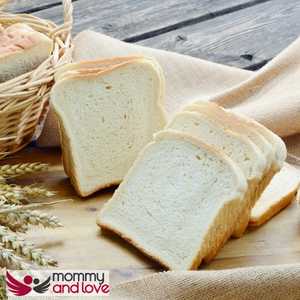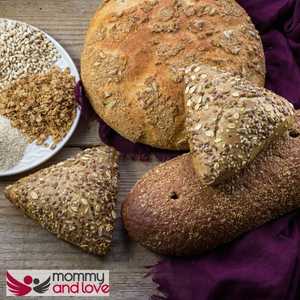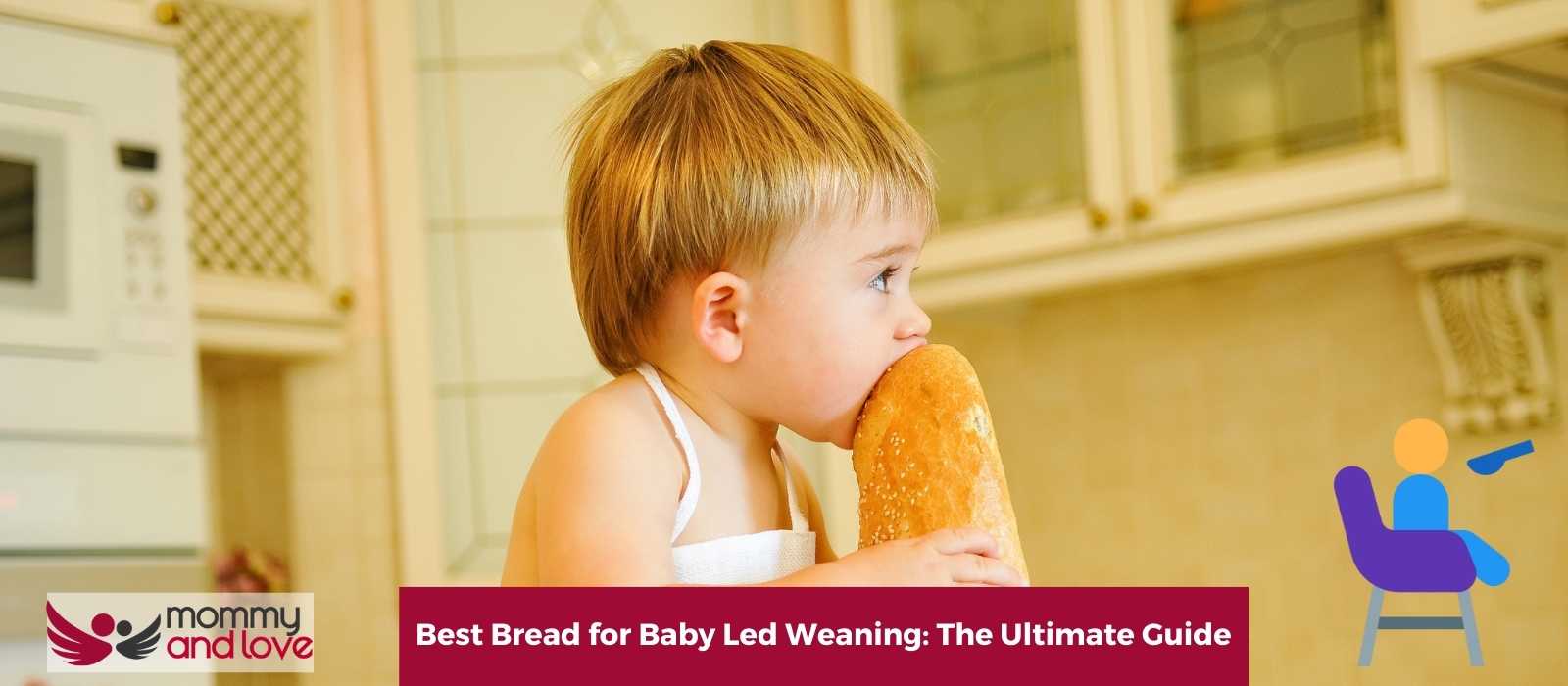Do you want to start baby-led weaning but don’t know where to start? Well, you’re in luck! In this blog post, we will discuss bread for baby self-feeding. We will also provide tips on how to transition your child to solid foods.
Baby-led weaning is a great way to introduce your child to solid finger foods when they are starting solids and help them develop healthy eating habits and prevent picky eating later in life. So, keep reading.
What Are the Benefits of Bread for Babies?
Bread is a great source of nutrients for babies, including:
- Fiber – Bread is a good source of fiber, which helps to promote a healthy digestive system. It is an important part of a baby’s diet. It helps to keep them regular and can help to prevent constipation. Fiber is also important for heart health and can help to reduce the risk of developing obesity and type II diabetes later in life.
- Protein – There are many sources of protein that are suitable for babies. Breast milk is an excellent source of protein and bread can be a source of protein too. Bread provides essential proteins that help to build and repair tissues.
There are different breads that also contain other nutrients, vitamins and minerals. There are also breads that are iron-rich.
When Can Babies Eat Bread?
Babies can start eating bread at about 6 months of age. However, since bread is not a required food for babies (and most babies don’t really like it), there is no reason to offer it before your baby turns 7 or 8 months old.
Choose the best breads that suit your baby’s nutritional needs and chewing skills. Avoid breads that are made for adults such as sodium bread.
Is Bread a Choking Risk for Babies?
There is no definitive answer, as each case is unique. However, there are some general guidelines that parents can follow to help reduce the choking risk of their child on breads. For example, it is important to make sure that the bread is well-baked and soft before giving it to your baby.
You should also avoid giving your baby large pieces of bread, and instead opt for smaller pieces. Additionally, don’t give your babies bread with large seeds such as pumpkin seeds and sunflower seeds.
Lastly, always supervise your child while they are eating, and be sure to contact a doctor if you have any concerns.
Can Babies Be Allergic to Bread?
Yes, it is possible for babies to have an allergic reaction to bread. However, it is not as common as other food allergies such as milk or eggs. Symptoms of allergic reactions to bread can include rash around the baby’s mouth, hives, vomiting, diarrhea, and difficulty breathing. If you think your baby may be allergic to bread, talk to your doctor. They can perform tests to determine if your baby has a bread allergy.
If your baby is diagnosed with a bread allergy, you will need to avoid giving them bread and other products that contain wheat. This can be difficult, as wheat is found in many foods. However, there are many substitutes available that do not contain wheat. Talk to your doctor or a dietitian for more information on how to create a safe and healthy diet for your child.
What Are the Best Types of Bread for Baby Led Weaning?
There are a few things to consider when choosing the best bread for babies including:
Texture
The best texture for babies is one that is soft and easy to chew. You want to avoid breads that are hard or crusty, as it can be difficult for little ones to eat. Look for brands that make soft, fluffy bread specifically for infants and toddlers. These will be the easiest for your child to eat and digest.
Ingredients
Of course, you’ll also want to make sure the bread you select is healthy and free of any added sugar or artificial ingredients. Choose a bread that is made with simple ingredients and doesn’t contain added sugar or salt. Look for whole-wheat or grain breads that are made with simple, natural ingredients. These will be the healthiest option for your child and will help them to grow up strong and healthy.
Allergens
If your child has any food allergies, be sure to choose a bread that is safe for them to eat. This might seem obvious, but you would be surprised how many people make this mistake. Most breads can be potentially allergenic foods so make sure that you know what your child is allergic to before giving them bread. Also, check the bread’s ingredient list.
Now that you know what to look for in a slice of bread for baby-led weaning, let’s take a look at the best types of bread.
The best types of bread for babies are:
White Bread

This is a type of bread made from flour that has been bleached or treated with chemicals to make it whiter than other types of flour.
This gives the bread a softer texture and a milder flavor. This bread is often made into sandwich bread, rolls, or used for toast.
Wheat Bread
Wheat bread is a type of bread that is made from whole wheat flour. It has a higher fiber content than other bread and a nuttier flavor that comes from wheat flour.
Rye Bread
Rye bread is a type of bread that is made from rye flour. It is usually darker in color than other types of bread and has a distinct flavor. Rye bread is popular in many European countries and is often eaten as sandwich bread. It can also be used for making croutons or other snacks.
Oatmeal Bread
Oatmeal bread is a type of bread made with oatmeal. It is usually made with whole-grain oatmeal, but can also be made with quick oats or steel-cut oats. Oatmeal Bread has a nutty flavor and a chewy texture. It is often used for breakfast or as a snack.
Multi-grain Bread
Multigrain bread is a type of bread that is made with multiple types of grains. The most common grains used in multigrain bread are wheat, rye, and oats. Multigrain bread can also be made with other grains such as barley, quinoa, and millet. Multigrain bread is usually higher in fiber than white or wheat bread.
Sprouted Grain Bread

It is a type of bread that uses whole grains that have been sprouted. The process of sprouting whole grains helps to break down the carbohydrates and make them more easily digestible for people with Celiac disease or other digestive disorders.
Sprouted grain bread is also a good source of fiber and nutrients, and it has a lower glycemic index than traditional bread.
How to Introduce Bread to Your Baby during Weaning
Now that you know what the best types of bread are, it’s time to learn how to introduce bread to your baby during weaning.
Here are a few tips:
- Start with small pieces of sliced bread that your baby can easily hold and gum.
- Choose soft breads instead of hard ones. Avoid ones with added sugars, your child doesn’t need those. You can prepare bread and make it lightly toasted.
- Lightly toasting the bread and cutting it into thick strips is also another way to serve it to your child.
- Offer the sliced bread plain or serve bread with a spread like a nut butter or cream cheese.
- Let your baby feed themselves and don’t worry if they make a mess.
- If your baby isn’t interested in bread, serve bread at another time.
Bread is a healthy and delicious food that can be introduced to your baby during weaning. Just be sure to choose the right type of bread and start with small pieces. Before you know it, your baby will be a pro at eating bread!
What Other Foods Can You Pair Bread With?
Some other foods to pair with bread for babies are:
- Nut butters
- Mashed berries
- Mashed beans
- Sliced banana
- Cottage cheese
- Hummus
- Mashed avocado
Bread is a versatile food that can be paired with many different items. Just be sure to choose something that your baby can gum or mash easily. If you’re not sure what to pair with bread, start with one of these items and see how your baby likes it.
Conclusion
Bread is a healthy and delicious finger food that can be introduced to your baby during weaning. Just be sure to choose the right type of bread and start with small pieces. Before you know it, your baby will be a pro at eating bread! If you think your child may have a bread allergy, talk to your doctor. They can help you create a safe and healthy diet for your child. bread is not a required food for babies (and most babies don’t really like it), there is no reason to offer it before your baby turns
Bread can be a choking hazard for babies, so it’s important to take precautions when introducing it to your child. Be sure to choose a well-baked, soft bread and cut it into small, bite-sized pieces. Always supervise your child while they are eating, and contact a doctor if you have any concerns.

This article was written by Sandra Baker – full time writer and the mother of four amazing kids (including twins!)
She’s also a breastfeeding counselor and has spent years helping new parents learn how to care for their children. When she’s not writing or caring for her children, Sandra likes to spend time reading and taking walks with her husband.




